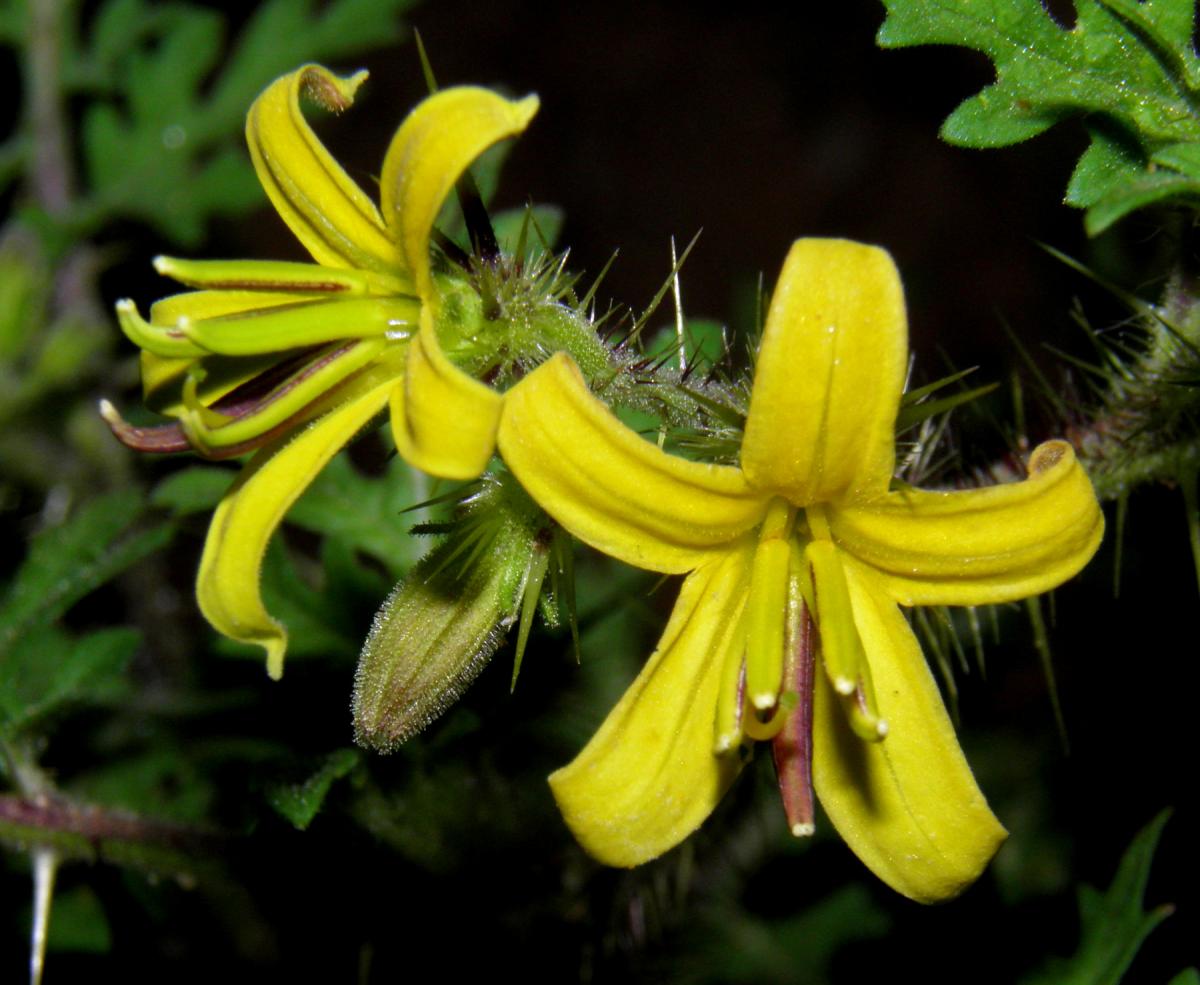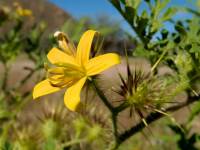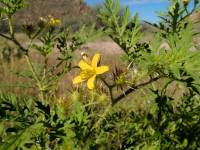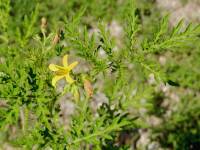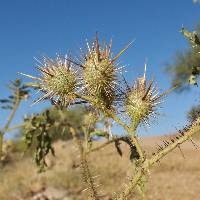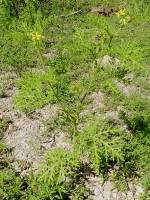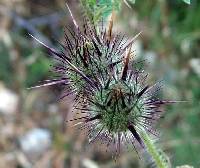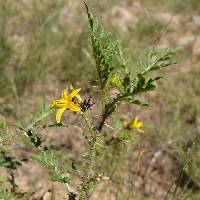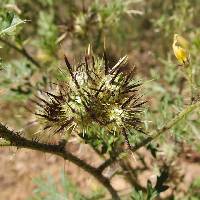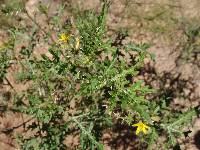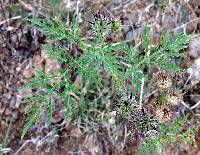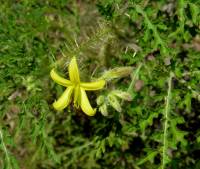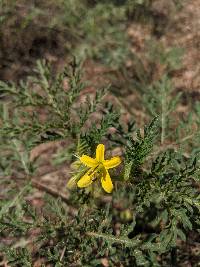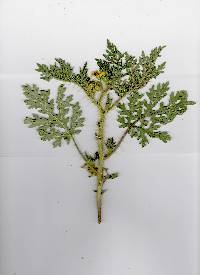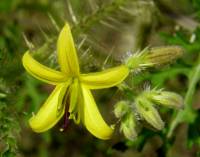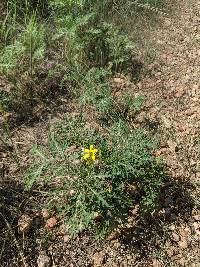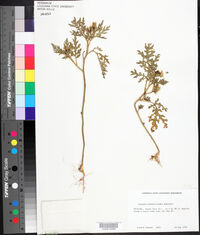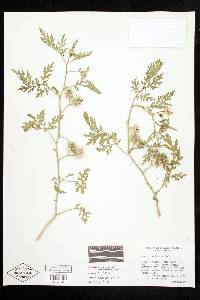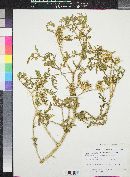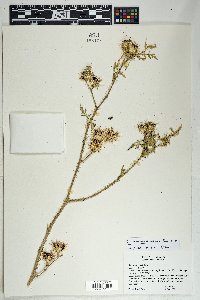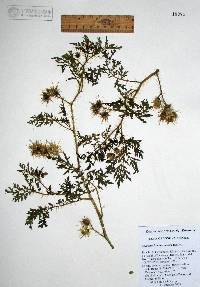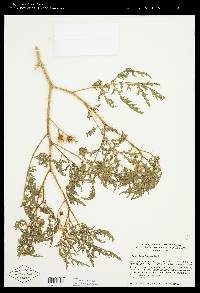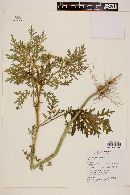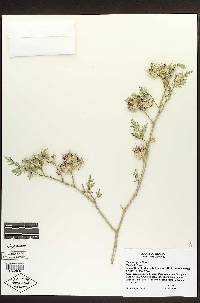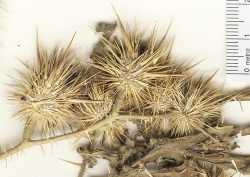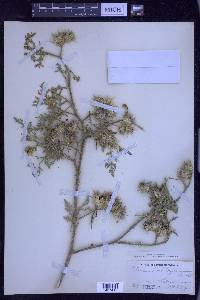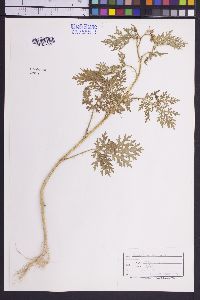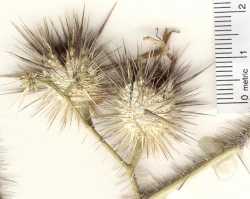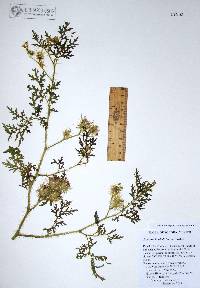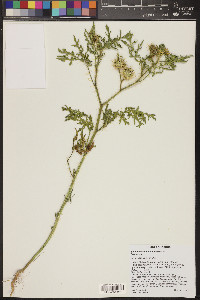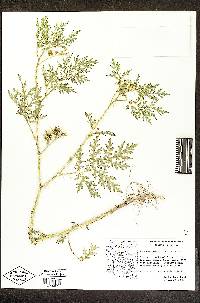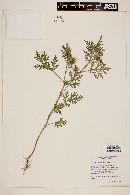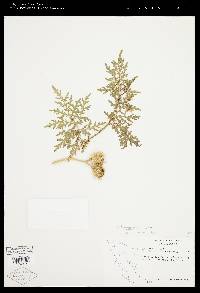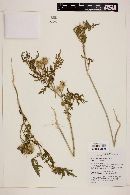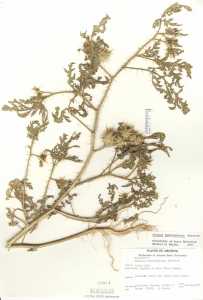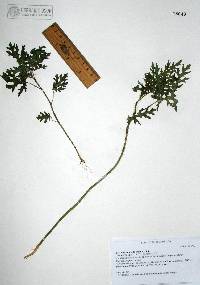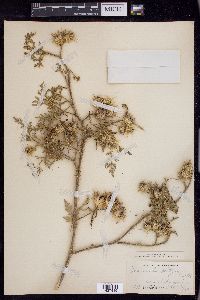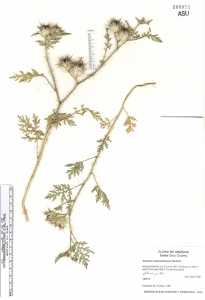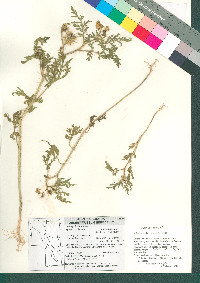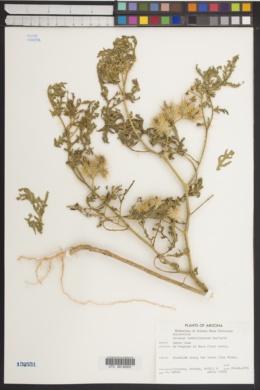
|
|
|
|
Family: Solanaceae
Sonoran Nightshade, more... (es: mala mujer)
|
PLANT: Annual herbs, taprooted, without tubers or stolons, 20-70 cm tall, pubescent, armed with prickles 4-9 mm long; hairs up to 0.7 mm long, simple over most of the plant, frequently gland-tipped. LEAVES: alternate, deeply dissected, bipinnatifid to tripinnatifid or compound, broadly ovate, 5-13 cm long, with stellate trichomes and simple, gland-tipped trichomes on the upper and lower surface, the stellate trichomes with 4-5 rays, the main veins armed with scattered prickles; petioles 2.5-7 cm long, armed with prickles; base of leaf or leaflets variable, acute to subcordate; apices of ultimate lobes obtuse to acute. INFLORESCENCE: 3-8 cm long, raceme-like monochasialcymes, 6-10-flowered, peduncles 0.5-3 cm long. FLOWERS: somewhat zygomorphic, perfect or having nonfunctional stigmas and abortive ovules in the terminal portions of the inflorescence; pedicel 0.5-1.5 cm long; calyx campanulate, the tube 1.8-2.2 mm long, the lobes linear-lanceolate, 5-12 mm long; corollas stellate, 1.3-1.8 cm wide, yellow; stamens unequal; anthers oblong, of three sizes, the lowermost extended anther 6.5-8.6 mm long, occasionally purple-tinged, incurved at the tip, the two adjacent shorter anthers 5.6-7.5 mm long, also terminally incurved, the uppermost shortest pair 4.5-6 mm long; filaments ca. 1/4 as long as the anthers; styles slender, extending out beyond the anthers; stigmas to 0.5 mm across. FRUITS: broadly ovoid, 1.1-1.4 cm in diam., tightly invested by the densely armed accresent tube of the calyx; seeds dark brown, 3-3.5 mm long, broadly ovate to suborbicular, radially ridged. NOTES: Sandy or gravelly soils of washes, stream-banks, hillsides, or occasionally roadsides: Pima, Santa Cruz cos. (Fig. 2C); 1020-1400 m (3350-4550 ft); Jul-Oct; s AZ; n Mex. REFERENCES: Chiang, F. and L.R. Landrum. Vascular Plants of Arizona: Solanaceae Part Three: Lycium. CANOTIA 5 (1): 17-26, 2009. Chiang et al. 2009, Kearney and Peebles 1969 Duration: Annual Nativity: Native Lifeform: Forb/Herb General: Herbaceous annuals, stems 20-70 cm tall, surfaces pubescent, armed with prickles 4-9 mm long, the spines, when fresh, nearly black at the base, surfaces also with hairs up to 0.7 mm long and frequently gland-tipped, plants taprooted, without tubers or stolons. Leaves: Alternate, deeply dissected, bipinnatifid to tripinnatifid or compound, broadly ovate in outline, leaf segments linear or lanceolate, acute or acutish, 5-13 cm long, bases of leaf or leaflets variable, acute to subcordate, apices of ultimate lobes obtuse to acute, surfaces with stellate trichomes and simple, gland-tipped trichomes on the upper and lower surface, the stellate trichomes with 4-5 rays, the main veins armed with scattered prickles, petioles 2.5-7 cm long, armed with prickles. Flowers: Yellow, corollas stellate, somewhat zygomorphic, 1.3-1.8 cm wide, perfect or having nonfunctional stigmas and abortive ovules in the terminal portions of the inflorescences, calyxes campanulate, tubes 1.8-2.2 mm long, lobes linear-lanceolate, 5-12 mm long, stamens unequal, anthers oblong, of three sizes, the lowermost extended anther 6.5-8.6 mm long, occasionally purple-tinged, incurved at the tip, the two adjacent shorter anthers 5.6-7.5 mm long, also terminally incurved, the uppermost shortest pair 4.5-6 mm long, filaments one-fourth as long as anthers, styles slender, extending out beyond the anthers, stigmas to 0.5 mm across, inflorescences 3-8 cm long, raceme-like, 6-10-flowered, peduncles 0.5-3 cm long, pedicels 0.5-1.5 cm long. Fruits: Berries, broadly ovoid, 1.1-1.4 cm in diameter, tightly invested by the densely armed accresent tube of the calyx, seeds dark brown, 3-3.5 mm long, broadly ovate to suborbicular and radially ridged. Ecology: Found on sandy or gravelly soils, in washes, on stream-banks, hillsides, or occasionally roadsides, from 3,000-4,000 ft (914-1219 m); flowering July-October. Distribution: Arizona; Mexico. Notes: Look for this species in Santa Cruz and Pima counties in Arizona. Ethnobotany: Unknown, but other species in the genus have uses; decoction of root taken as a general tonic, for tuberculosis, heart trouble, and fruits used to prepare a permanent blue dye for tattooing. Synonyms: None Editor: LCrumbacher2012 Etymology: Solanum is Latin for "quieting," in reference to the narcotic properties of some species, the meaning of lumholtzianum is unknown. |
|
|
|
This project was made possible in part by the Institute of Museum and Library Services [MG-70-19-0057-19].
Powered by Symbiota

